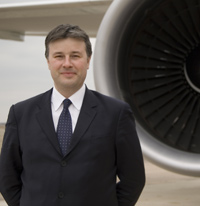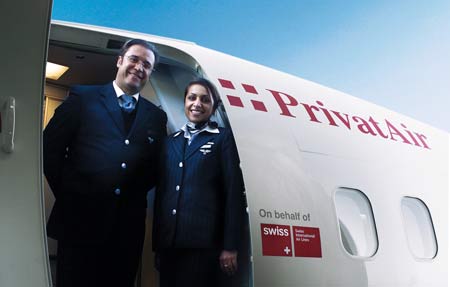PrivatAir is not exactly a household name but the Swiss carrier has played an important role creating an all-premium operation in the airline industry. Lufthansa is generally credited as the first carrier with an all-premium operation, first trialling the concept in 2002 on the Dusseldorf-Newark route. But without PrivatAir, Lufthansa would not have been able to try out the new model.
PrivatAir supplied Lufthansa its first business jet and today operates all three of the aircraft in the German carrier’s all-premium operation. PrivatAir also supplies the business jets behind the all-premium operations of KLM and Swiss, and did the initial studies for
Thomas sees a growing market for wet-leasing business jets to airlines but says PrivatAir will not stray into offering its own scheduled services: “This year we’re celebrating our 30th anniversary and we haven’t sold a single ticket yet. It’s not in our ambitions. We have looked at it in the past but we fully believe in the distribution powers of our airline clients.”
Private charter PrivatAir, which mainly operates business jets for private charter customers, initially took the idea of a scheduled all-premium operation from
PrivatAir, which mainly operates business jets for private charter customers, initially took the idea of a scheduled all-premium operation from
For its three airline customers, Geneva-based PrivatAir provides all in-flight crews and aircraft which carry the PrivatAir brand. Thomas boasts customer feedback forms show the service his crews provide is better than the service typically provided in the business class cabin on legacy carriers. As a result, airlines are happy to have PrivatAir responsible for the service and are not interested in putting their own colours on the aircraft they wet-lease from PrivatAir.
“It’s been a success story from the beginning,” says Lufthansa vice-president sales and services Europe Karten Benz.
Benz adds Lufthansa plans to stick with a wet-leased arrangement for its all-premium operation because having a small sub-fleet for all-premium services would not be efficient. Lufthansa has Airbus A319s and Boeing 737s in its mainline fleet but Benz says these aircraft are still different from their business jet derivatives, the A319LR and Boeing Business Jet, which PrivatAir operates for Lufthansa. Thomas says A319LR and BBJ have different landing gear and extra fuel tanks. He adds it is also hard to secure financing for A319LRs and BBJs because they are so unique and this in turn makes it hard for airlines to acquire them. “It’s not a slam dunk for financiers and lessors,” Thomas says.
Airlines also prefer not to own business jets – Thomas claims ANA only decided to acquire all-premium aircraft because it could not secure Japanese approval to wet-lease aircraft from PrivatAir – because the risk is too high. To trial a concept such as all-premium operations it is much less risky to wet-lease an aircraft and use a relatively small aircraft. Thomas claims a 767 cost 50% more to operate than a BBJ and a 757 costs 20% more – all four all-premium start-ups use 757s and 767s.
For all these reasons Thomas is confident PrivatAir’s Private Airline Services division will secure several new customers. Several airlines are now studying the all-premium concept and could be persuaded to launch operations if British Airways and Virgin Atlantic follow through on their plans to launch all-premium transatlantic operations next summer. “There’s clearly a lot of talk going on in the marketplace,” Thomas says.

Matching capacity with demand
All-premium operations are clearly more than just a passing fad. Lufthansa initially contracted PrivatAir for only one year, but it recently extended its commitment for another five years. “I don’t think it’s a niche market. It’s one more way to match capacity with demand. It’s a useful tool when airlines are ready to attack business-class markets,” Thomas says. “We’ll be in this market at least 10 years. I don’t think some of the start-ups will be.”
The recent EU-US open skies agreement also gives PrivatAir the ability to wet-lease aircraft to US carriers. So far US majors have shied away from launching all-premium operations but Thomas thinks that will change as long as they can overcome union resistance to wet-leases: “We see a lot of interest from them. There are forward-thinking airlines in the
In addition to operating aircraft on behalf of airlines, PrivatAir has a fast-growing charter division, which uses a larger fleet of business jets that range from small Cessna Citations to Boeing 767s. It even has one Boeing 787 on order for delivery in 2012 and holds an option for a second 787. PrivatAir has not yet decided how it will use 787s, but Thomas says most likely they will be used in the private charter market and configured with about 50 first-class seats.
“Realistically when it comes to seat mile costs I don’t see airlines committing to a 50-seat 787,” he says.
PrivatAir’s charter division now operates a 757 with 64 seats in three-class configuration. Thomas says this aircraft is generally used to fly delegations for countries that do not have their own VIP aircraft. PrivatAir also operates two A319s to shuttle Airbus employees between production sites in
“So far it is doing well. I wouldn’t rule out getting a second one,” Thomas says.

Source: Airline Business
















